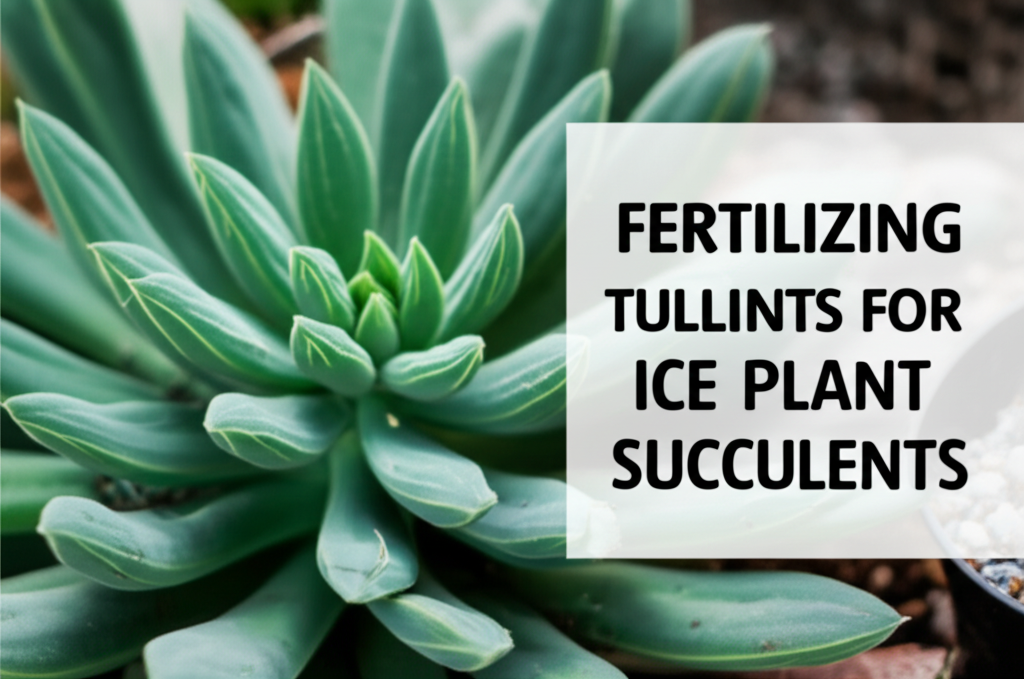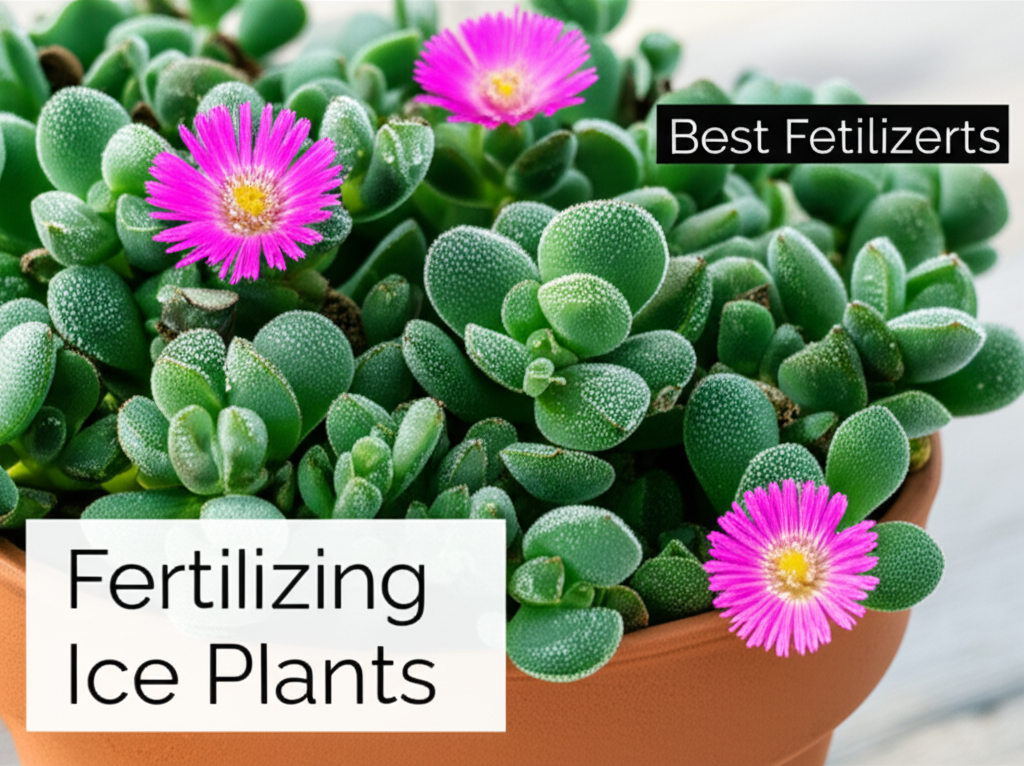Ice plants, with their dazzling, dew-like foliage and vibrant, daisy-like blooms, are a captivating addition to any succulent collection or low-water garden. These resilient plants, scientifically known as members of the Aizoaceae family, are renowned for their ability to thrive in arid conditions and tolerate coastal salt spray. While they are remarkably low-maintenance, providing them with the right nutrients at the opportune times can significantly enhance their growth, flowering, and overall health. Choosing the best fertilizer for your ice plant succulents involves understanding their specific needs and the benefits different nutrient profiles offer.
Understanding Ice Plant Nutritional Needs
Ice plants, like most succulents, are not heavy feeders. Their natural habitat often involves nutrient-poor soils, meaning they have adapted to survive and even flourish with minimal supplemental feeding. Over-fertilizing can be detrimental, leading to leggy growth, reduced flowering, and an increased susceptibility to pests and diseases.
The key to successful ice plant fertilization lies in providing a balanced, diluted feed, primarily focusing on phosphorus and potassium to encourage blooming and root development, with a moderate amount of nitrogen for foliage health.
Key Nutrients and Their Role
- Nitrogen (N): Crucial for leaf and stem growth, and chlorophyll production. Too much nitrogen can lead to soft, stretched growth that is more prone to pests and diseases.
- Phosphorus (P): Essential for root development, flowering, and seed production. It’s particularly important for encouraging the abundant blooms ice plants are known for.
- Potassium (K): Aids in overall plant health, disease resistance, and water regulation. It also contributes to the plant’s ability to withstand environmental stresses like drought and extreme temperatures.
- Micronutrients: Though needed in smaller amounts, trace elements like iron, magnesium, and calcium are vital for various physiological processes, including photosynthesis and enzyme function.
When to Fertilize Your Ice Plant

The best time to fertilize ice plants is during their active growing season, which typically coincides with spring and summer. Avoid fertilizing during their dormancy period, usually in fall and winter, or when the plant is stressed due to extreme heat or drought.
- Spring: As new growth begins to emerge and temperatures warm up, a light feeding can provide the necessary boost for vigorous development and budding.
- Summer: A second, similarly diluted feeding can support continued flowering and growth throughout the warmer months.
- Avoid Fall/Winter: During cooler periods, ice plants slow down their growth. Fertilizing at this time can disrupt their natural cycle and potentially harm the plant.
Types of Fertilizers Suitable for Ice Plants
When selecting a fertilizer for your ice plant succulents, it’s best to opt for formulas that are specifically designed for succulents and cacti or general-purpose fertilizers that can be diluted significantly.
1. Balanced Liquid Fertilizers
Liquid fertilizers are often preferred for succulents because they are easy to dilute and apply, allowing for precise control over the nutrient concentration. A balanced fertilizer with a ratio like 10-10-10 or 15-15-15 can be used, but it’s crucial to dilute it to ¼ or ½ strength.
2. Slow-Release Fertilizers
Granular, slow-release fertilizers offer a convenient option, providing nutrients over an extended period. These are typically incorporated into the soil mix at the beginning of the growing season. Look for formulations with a lower initial nitrogen release to prevent sudden, weak growth.
3. Organic Fertilizers
For those who prefer a more natural approach, organic fertilizers can be beneficial. These include compost, worm castings, and fish emulsion. Organic options generally release nutrients more slowly, reducing the risk of over-fertilization.
- Compost and Worm Castings: These can be mixed into the soil annually or used as a top dressing. They improve soil structure and provide a steady, slow release of nutrients.
- Fish Emulsion: A diluted fish emulsion can provide a nitrogen boost, but it’s important to choose a product with a balanced NPK ratio and dilute it significantly. Be mindful of its potential odor.
4. Specialized Succulent Fertilizers
Several brands offer fertilizers specifically formulated for succulents and cacti. These often have a lower nitrogen content and higher phosphorus and potassium levels, which are ideal for promoting flowering and root health without encouraging excessive leafy growth.
Comparing Popular Fertilizer Options
Here’s a look at how different types of fertilizers stack up for ice plant succulents:
| Fertilizer Type | NPK Ratio (Typical) | Pros | Cons | Best For |
|---|---|---|---|---|
| Balanced Liquid Fertilizer | e.g., 10-10-10, 15-15-15 | Easy to control dilution, quick absorption | Risk of over-fertilization if not diluted properly | General feeding during growing season |
| Low-Nitrogen Liquid Fertilizer | e.g., 5-10-10, 2-7-7 | Promotes flowering, reduces leggy growth | May require more frequent application than slow-release | Encouraging blooms, maintaining compact growth |
| Slow-Release Granular | Variable (e.g., 14-14-14, 10-20-10) | Convenient, provides nutrients over time | Less control over nutrient release, can leach | Initial soil amendment, long-term feeding |
| Organic Compost/Worm Castings | Variable (low NPK, rich in micronutrients) | Improves soil structure, gentle nutrient release, sustainable | Can be bulky, nutrient content can be inconsistent | Soil amendment, gentle feeding, improving soil health |
| Diluted Fish Emulsion | e.g., 5-1-1 | Provides nitrogen and micronutrients, organic | Potential odor, can be too high in nitrogen if not diluted | Boosting growth, but with extreme caution on dilution |
How to Fertilize Your Ice Plant: A Step-by-Step Guide
Proper application is as crucial as choosing the right fertilizer. Follow these steps for optimal results:
Preparation and Dilution
- Water the Plant: Always water your ice plant thoroughly a day or two before fertilizing. Dry soil can lead to root burn when fertilizer is applied.
- Dilute Liquid Fertilizer: If using a liquid fertilizer, mix it with water according to the package directions. For ice plants, it is highly recommended to dilute it to ¼ or ½ strength, even if the label suggests otherwise. This is a key practice for succulents.
- Measure Slow-Release: If using granular fertilizer, follow the package instructions for application rates, ensuring it’s mixed into the top layer of soil or applied around the drip line of the plant.
Application
- Apply to Moist Soil: Pour the diluted liquid fertilizer evenly around the base of the plant, avoiding direct contact with the foliage or stems.
- Rinse if Necessary: If any fertilizer residue is on the leaves, rinse it off with plain water.
- Top Dressing (Organic): For compost or worm castings, gently spread a thin layer (about 1-2 cm) over the soil surface, keeping it away from the immediate base of the plant.
Frequency
- Fertilize once in early spring and again in early summer.
- Do not fertilize more than twice per growing season.
- If the plant is showing signs of stress, has recently been repotted, or is in a very poor soil mix, a very dilute feeding might be beneficial, but always err on the side of caution.
Signs of Over-Fertilization and Under-Fertilization
It’s important to recognize the signs your ice plant might be giving you regarding its nutrient levels.
Signs of Over-Fertilization:
- Fast, weak, “leggy” growth: Stems become elongated and spindly, with weak support.
- Wilting despite adequate watering: Excess salts from fertilizer can damage roots, hindering water absorption.
- Leaf tip burn or browning: The edges or tips of leaves may turn brown or crispy.
- Reduced flowering: Paradoxically, too much nitrogen can inhibit bloom production.
- Salt crust on soil surface: Visible white or yellowish crystalline deposits.
Signs of Under-Fertilization:
- Slow or stunted growth: The plant appears to be growing very little.
- Pale or yellowish leaves: Particularly older leaves may lose their vibrant green color.
- Sparse or no flowering: If your ice plant isn’t blooming, it might need a slight boost in phosphorus and potassium.
- General lack of vigor: The plant may look unhealthy or less robust.
Pros and Cons of Fertilizing Ice Plants
Here’s a summary of the benefits and potential drawbacks of fertilizing ice plants:
| Pros | Cons |
|---|---|
| Promotes more abundant and vibrant flowering. | Risk of root burn or plant damage if over-applied. |
| Encourages healthy foliage growth and color. | Can lead to leggy, weak growth if too much nitrogen is applied. |
| Improves overall plant vigor and resilience to stress. | Over-fertilizing can attract certain pests and diseases. |
| Can help plants establish faster in new beds or containers. | Requires careful monitoring of plant health and environmental conditions. |
| Can supplement nutrients in nutrient-poor soil mixes. | Unnecessary if the plant is already healthy and growing well in a good soil. |
Choosing the Right Soil Mix
While fertilizer is important, the foundation for a healthy ice plant is the soil it grows in. A well-draining soil mix is paramount for succulents.
- Cactus/Succulent Potting Mix: This is readily available and formulated for excellent drainage.
- DIY Mix: Combine equal parts potting soil, coarse sand, and perlite or pumice. This ensures adequate aeration and prevents waterlogging.
A good soil mix provides essential aeration and drainage, which are even more critical for succulents than a rich nutrient supply.
Conclusion
Fertilizing ice plant succulents is a nuanced practice that emphasizes moderation and timing. By understanding their natural needs and choosing appropriate, diluted fertilizers, you can significantly enhance the beauty and vitality of these remarkable plants. Opt for balanced, low-nitrogen formulas, apply them sparingly during the active growing season, and always prioritize excellent drainage in your soil mix. With a little care and the right nourishment, your ice plants will reward you with a spectacular display of color and resilient charm year after year.


